Discover the scientific intricacies behind ramen noodles: from alkalinity to gluten, hydration, and beyond. Explore the secrets of perfect noodle crafting.
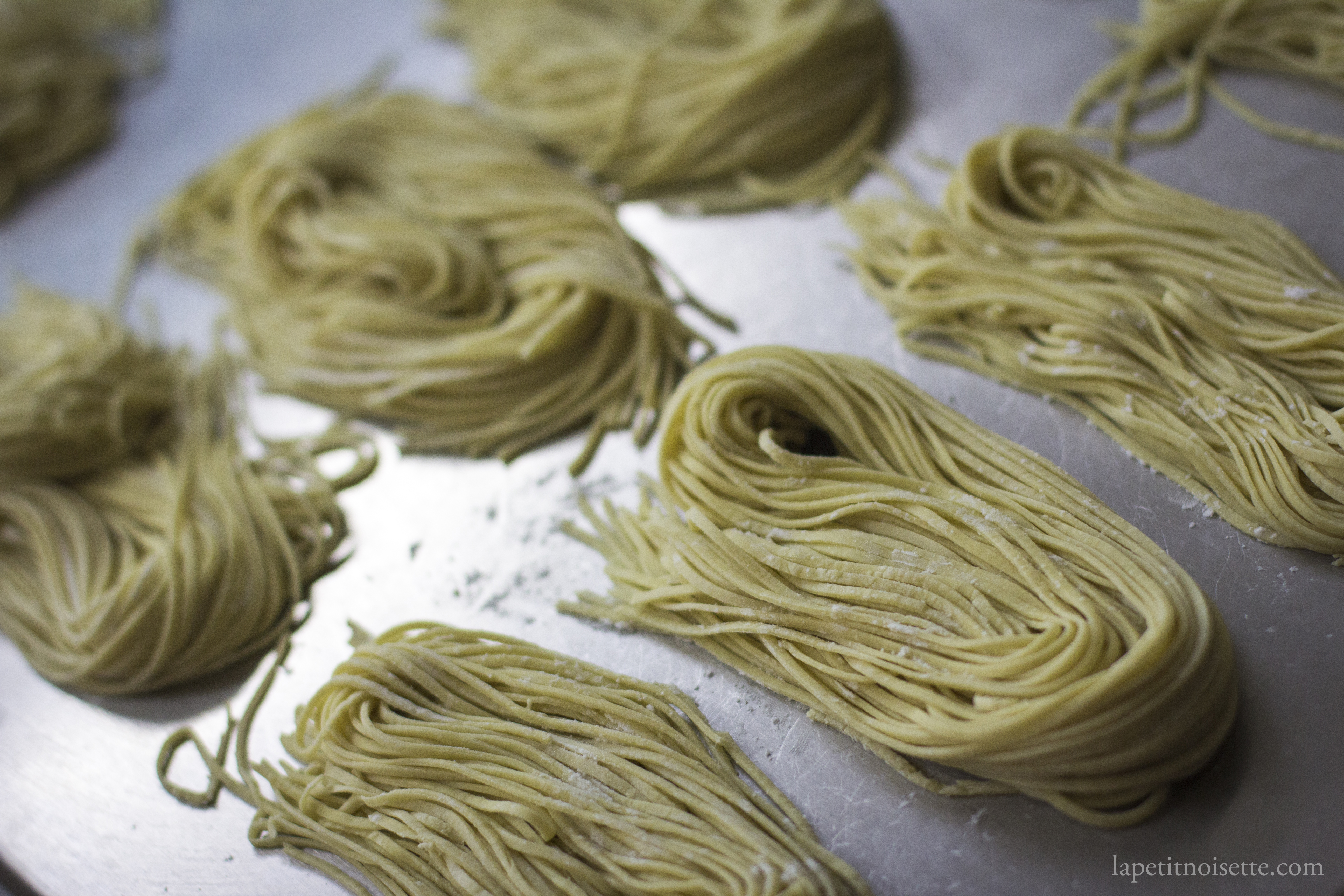
How and Why to Make Ramen Noodles Alkaline
The source of alkaline salts in ramen noodles typically comes from kansui powder or sodium carbonate. Both liquid and powdered kansui was originally made by harvesting alkaline crystals from lake shores in China. These were later dissolved and boiled down to make powder. Nowadays, kansui is manufactured by adding a predetermined proportion of potassium carbonate and sodium carbonate. Only a small amount of kansui is needed – 1-1.5% of the weight of the flour in the dough.[1]
Liquid kansui has more potassium carbonate than powdered kansui. This is because potassium ions have a greater ionic radius than sodium ions. This greater ionic radius allows it to be more soluble in water, and more stable in liquid form.
Potassium carbonate and sodium carbonate produce different effects on the noodles: potassium carbonate hardens, but also produces a greater yellow colour[2] and an alkaline smell. Sodium carbonate mostly softens. Thus, the ratios of the alkaline salts used is important, and so is the type of kansui.
Potassium carbonate is hard to make at home, but sodium carbonate is easily made by heating baking soda (sodium bicarbonate). Above 80°C sodium bicarbonate breaks down to form water, carbon dioxide and sodium carbonate:
2NaHCO3 (s) + Heat → Na2CO3 (s) + H2O (g) + CO2 (g)
The above equation occurs in two steps. When sodium carbonate is dissolved in water, it produces two sodium ions (Na+) and one carbonate ion (CO32-). The carbonate ion picks up two hydrogen ions and forms carbonic acid (H2CO3). This acid that is then neutralized by the hydroxide ions (OH–) left over:
Na2CO3 + H2O → Na2O + H2CO3 → H2O +CO2 + 2NaOH + Heat
The rate at which this reaction occurs in an oven is dependent on the temperature of the oven and the surface area of the sodium bicarbonate. The higher the temperature and surface area, the faster the reaction. The reaction is complete when the sodium bicarbonate is 2/3 of the original starting weight.[3]
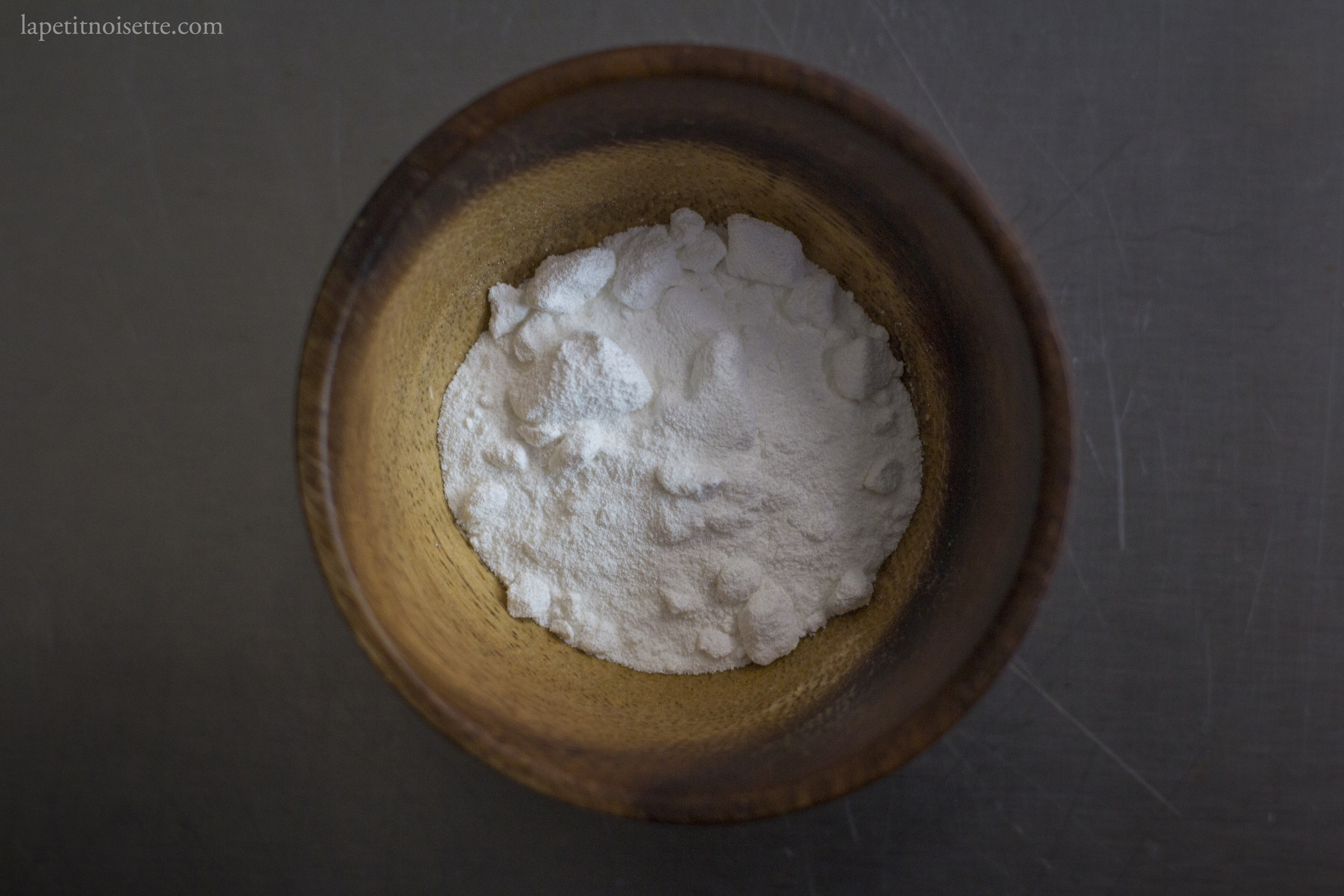
Gluten and its effects
The two main proteins that make up gluten are gliadin and glutenin, both which are insoluble in water. Gliadin increases the noodle’s stretching and extending abilities, whilst glutenin provides elasticity and resistance the stretching.
Gluten is insoluble and hydrophobic, but is able to absorb around twice is weight in water. As the gluten is hydrated, the gluten proteins start to connect to each other through disulfide and non-disulfide cross-links. Kneading dough increases[4] the number of cross-links formed. These eventually become large networks of protein, which in turn become sheets of protein. Because gluten is hydrophobic, the higher the gluten content, the longer the cooking time of noodles.
More gluten also means more cross-links. This makes food chewier. This can be seen in bread flour (12-14% protein) vs. cake flour (8-10% protein). We like our cakes to be soft and fluffy, and our bread to be chewy.
Ramen noodle flour typically has a higher protein content than bread flour. In order to achieve such high protein, vital wheat gluten is added. One possible explanation for why a higher protein content is needed may be the effect of pH on gluten formation.
Hydration and its effects
Put simply, hydration is the amount of water added to your flour mixture, and is typically presented as a percentage of the total flour mass (baker’s percentages). Different styles of ramen across Japan have varying levels of hydration which affect the texture of the dough though gluten formation. The amount of water also should be varied depending on the weather, since air humidity affects dough hydration.[5]
The lower the dough’s hydration, the harder it is to combine the flour and dough together. Hakata-style ramen, which is famous for extremely low levels of hydration, is impossible to knead by hand and is typically kneaded together with a machine. Udon noodles are also tough to knead. As a result they are sometimes kneaded by stepping on the dough on a bag on the floor.
Low hyrdration also makes the noodles straighter, and gives them more snap, since the gluten formation and tensile strength[6] is reduced. This is what gives Hakata noodles their characteristic bite. Tsukemen noodles on the other hand tend to have a higher hydration, which prevents the thick noodles from being too brittle.
When heated, gluten proteins contract as they coagulated and denature – this is what makes noodles curl when cooked.
As mentioned earlier, gluten is hydrophobic, so it increases cooking time. Wetter doughs have a reduced cooking time though, since the starches are hydrated. The way these two variables affect each other means there isn’t a linear relationship between hydration and gluten development, and cooking time[7].
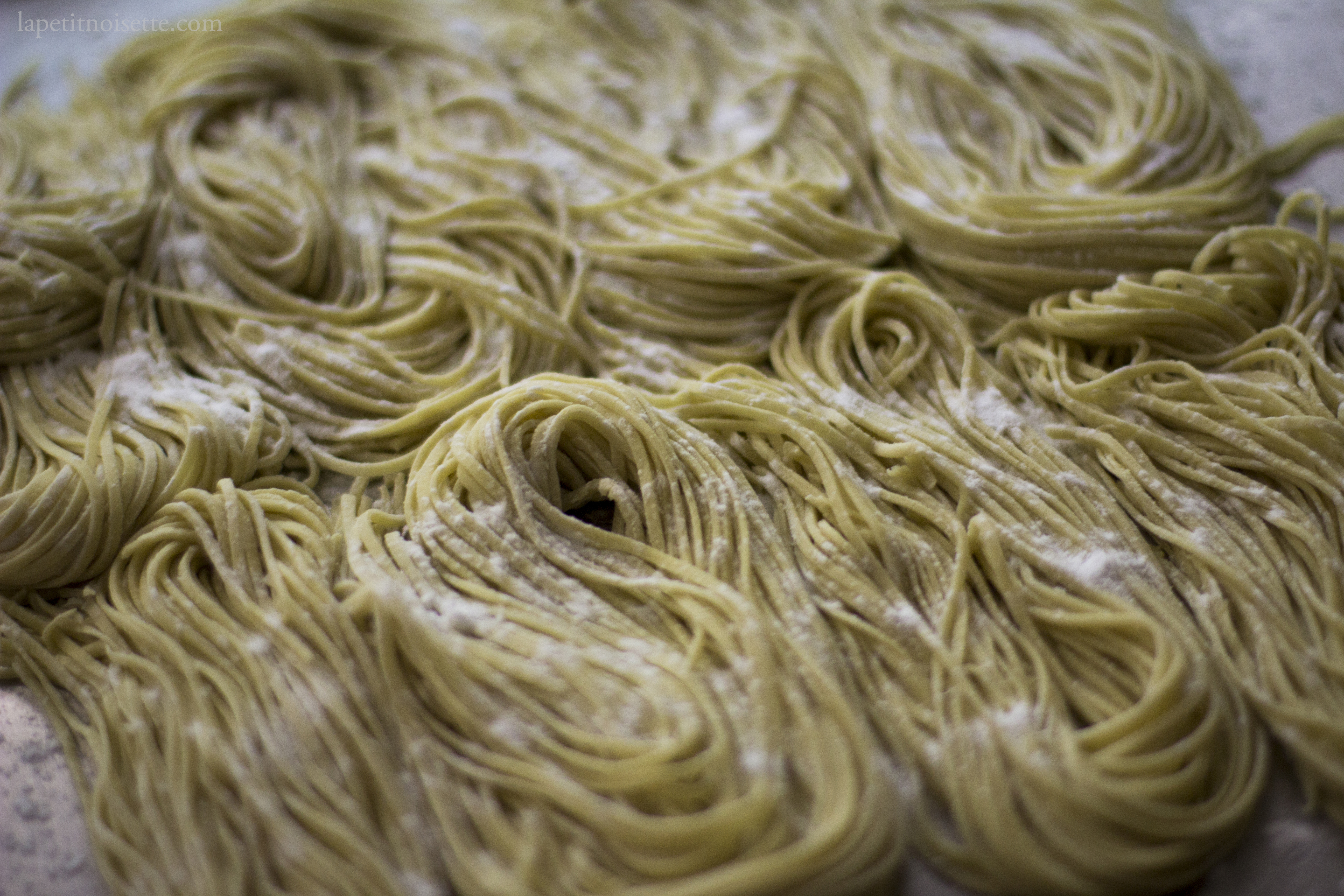
Water PH and its effects
The optimum pH for gluten formation is between pH 5 and pH 6. Raising and lowering the pH changes how stretchy the dough is. Soft water is water with a lower pH (more acidic <7) and a lower ppm[8] (0 to 1), and hard water is water with a higher pH (>7) and a ppm above 1. As alkaline salts are already added to ramen noodles, it is better to use soft water when cooking to avoid inadvertently affecting noodle pH.
Furthermore, the hardness of the water can also affect the rate of water absorption in the noodles when cooking. Harder water causes lower water absorption which means that it will take a longer period of time to cook the noodles, and makes them go mushy more quickly. Conversely, cooking ramen noodles in softer water shortens cooking time, and helps noodles maintain their texture for longer.
Salting and its effects
The amino acids which make up gluten have a net positive charge. The positive charges between gluten molecules repel each other, spreading out the gluten network. When salt is added, the salt ions neutralise the charge and cause the gluten in the flour to tighten. This makes it stronger and more elastic.
This also means that the hydration of the dough will slightly reduce as the amount of water trapped between gluten molecules decreases. Whilst this can be useful, on an industrial scale is can cause problems as a stronger gluten matrix will mean that the time needed to mix and knead the dough together will be longer. At home however, it aids in protecting the noodle dough from being over kneaded. Furthermore, salt prevents bacterial growth and helps preserve the shelf life of dry noodles. Very high levels (over 8%, as opposed to the more normal 1-2%) of salt dry out noodles, and also reduces boiling times.[9]
Resting and its effects
After the noodle dough is combined, it is usually rested for a short period of time before being rolled out into a sheet. Some recipes even call for a second rest after the noodles have been passed through the noodle machine and before they are cut. When left to rest, the gluten network in the noodle dough starts to relax, in the same way that muscles in our body relax after exercise. This causes it to be easier to work with and shape, while also allowing the gluten strands in the dough to be easily realigned.
During the resting period gluten continues to form. During this period, enzymes in the flour called proteases start to break down gluten bonds. Whilst the expected result is that this would cause the noodles to lose their strength and elasticity, it in-fact increases the overall quality of the noodles are the strands of glutens that have been broken by the proteases are now free to make additional bonds with each other, further increasing the gluten strand’s ability to be realign. Attempting to roll out an unrested dough will prove hard and the dough will be so elastic that it constantly bounces back to its original shape.
Rolling and its effects
After the initial mixing, the gluten strands in the dough are randomly oriented in different directions and bunched together in some parts. At this stage, it is important to realign the gluten strands into straight lines. This is done by repeatedly passing the ramen dough through the noodle machine without reducing the thickness. While doing this, it is important that the noodles are always fed into the machine in the same direction. As the dough the rolled repeatedly, the gluten networks are realigned as it is continuously stretched and pressed in the same direction. When done correctly it will be possible to see the lines of gluten running all the way across the dough and you continuously roll it. This improves the texture of the noodles by giving it its characteristic bite, whilst also preventing the noodles from curling too much when cooking.
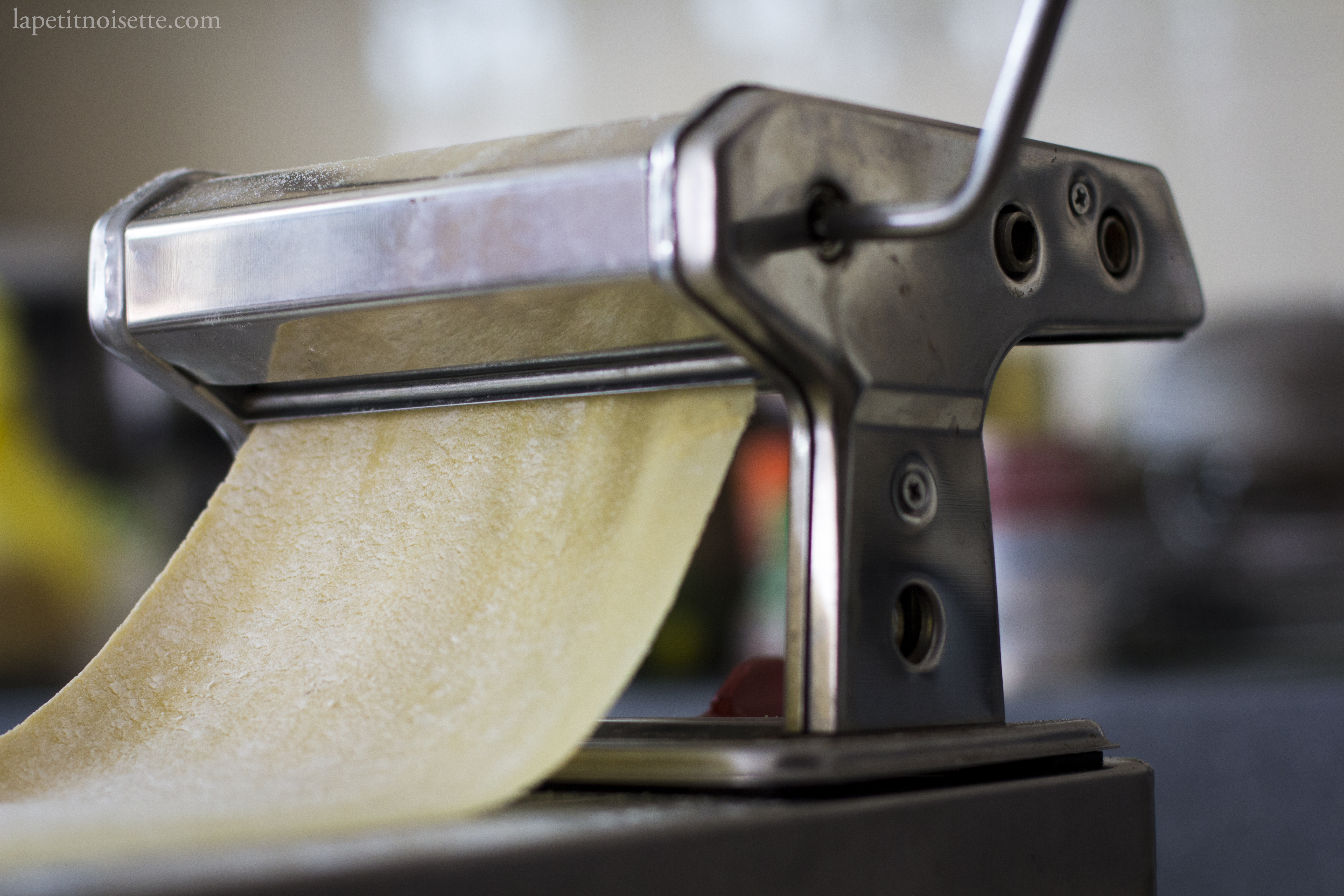
Ageing and its effects
You can age noodles at a low temperature (10-15C) to develop flavour. As the noodles age, the proteases in the noodles continue to breakdown gluten, although at a much slower rate due to the lower temperature. Whilst the breakdown of protein is not enough to affect the integrity of the noodles, the increase diversity of amino acids in the noodles due to protein breakdown improves the noodles’ flavour. Furthermore, dough hydration also evens out as water is slowly able to spread evenly through the noodles through osmosis.
Care should be taken when ageing noodles to ensure that bacteria grown does not occur. They should be rested only at a low temperature, in an airtight container or ziplock bag.
Bundling noodles together when aging them makes them more likely to curl. As the gluten strands spend a significant amount of time in a certain position during ageing, they tend to maintain that shape during cooking.
Dusting and its effects
Ramen noodles should not be dusted with wheat flour during rolling and after cutting as it is absorbed into the noodles, which changes noodles’ hydration and makes them stick anyway. Potato starch and cornstarch work better.[10]
Shocking and its effects
The main argument for shocking noodles in cold water straight after cooking is to prevent the noodles from overcooking. Adding cold ramen noodles to a bowl of hot soup will quickly bring down the temperature of the soup and therefore it is almost never done. However, tsukemen noodles are the exeption. This is because tsukemen noodles are much thicker in comparison and therefore are able to store significantly more heat inside, increasing the risk of over cooking. Tsukemen noodles are also dipped in their broth and not served in a soup, thus removing the risk of cooling down the soup. Shocking noodles in water also removes any additional starch from the surface of the noodle, which some people believe helps the soup cling to the noodles.
Straining and its effects
The method by which each individual ramen chef shakes and drains his noodles in a basket is unique and in a way it is each’s chef signature move. From simple to elaborate, they all serve the purpose of drying the noodles to stop the soup becoming dilute. Other than for putting on a good show (as ramen is usually served behind a counter like at a cocktail bar), I have yet to find any information regarding the effects of different straining technqiues. Any technique should suffice so long as the noodles are shaken vigorously and quickly to ensure as much water is removed as possible.
Rye and its effects
Rye flour has a higher ash content than wheat flour but also has a greater ability to absorb water than wheat flour. Rye flour contains pentosan sugars. These increase water absorption, and are fragile, which means that excess kneading and rolling of the dough will cause these sugars to release their water, causing the dough to go slightly soggy. Adding rye flour to tsukemen noodles gives a more complex flavour to the noodle while reducing the amount of hydration and gluten formation in the overall dough.
The ash content of a flour is the mineral content of a flour. This is measured by the weight difference between flour before and after it is incinerated (because minerals do not burn). The mineral content of a grain decreases from the outside to the inside of the grain, with the endosperm having the least minerals and therefore lowest ash content. The ash content of different types of flours also vary.
Flour with a higher ash content darkness noodles. A higher ash content also decreases the amount of gluten formation in the dough and thus would be beneficial to counteract the effects of high hydration if needed. This is especially useful in tsukemen noodles, where their thickness and means they can be too chewy.
Egg and its effects
Egg is not normally added to ramen noodles but is a common feature in pasta. This is especially true for egg yolks, which consist mainly of fat. Egg white however, is sometimes added to ramen noodles, especially industrially produced ones. Egg whites are 90% protein (albumins, mucoproteins, and globulins). This means that the addition of egg white to noodles increases its hydration. Typically, egg white powder is used to allow a more controlled addition without changing the hydration. If you intend to use whole egg whites in your noodles, remember to adjust the water accordingly.
The main effect of adding egg whites to noodles is not apparent until they are being cooked. This is because the denaturation of egg whites only occurs at high temperatures and any modification of albumin proteins before that requires significant mechanical force (think of making a meringue). When egg whites denature, the protein structure starts to unwind and coagulate together, reducing the amount of space between protein strands. This in turn reduces the ability of the noodles to absorb water, thus increasing their cooking time. It also contributes the same texture of cooked egg whites to the noodles. Egg white powder does not have the same properties as gluten proteins, and thus does not affect the mixing, kneading or rolling of the dough.
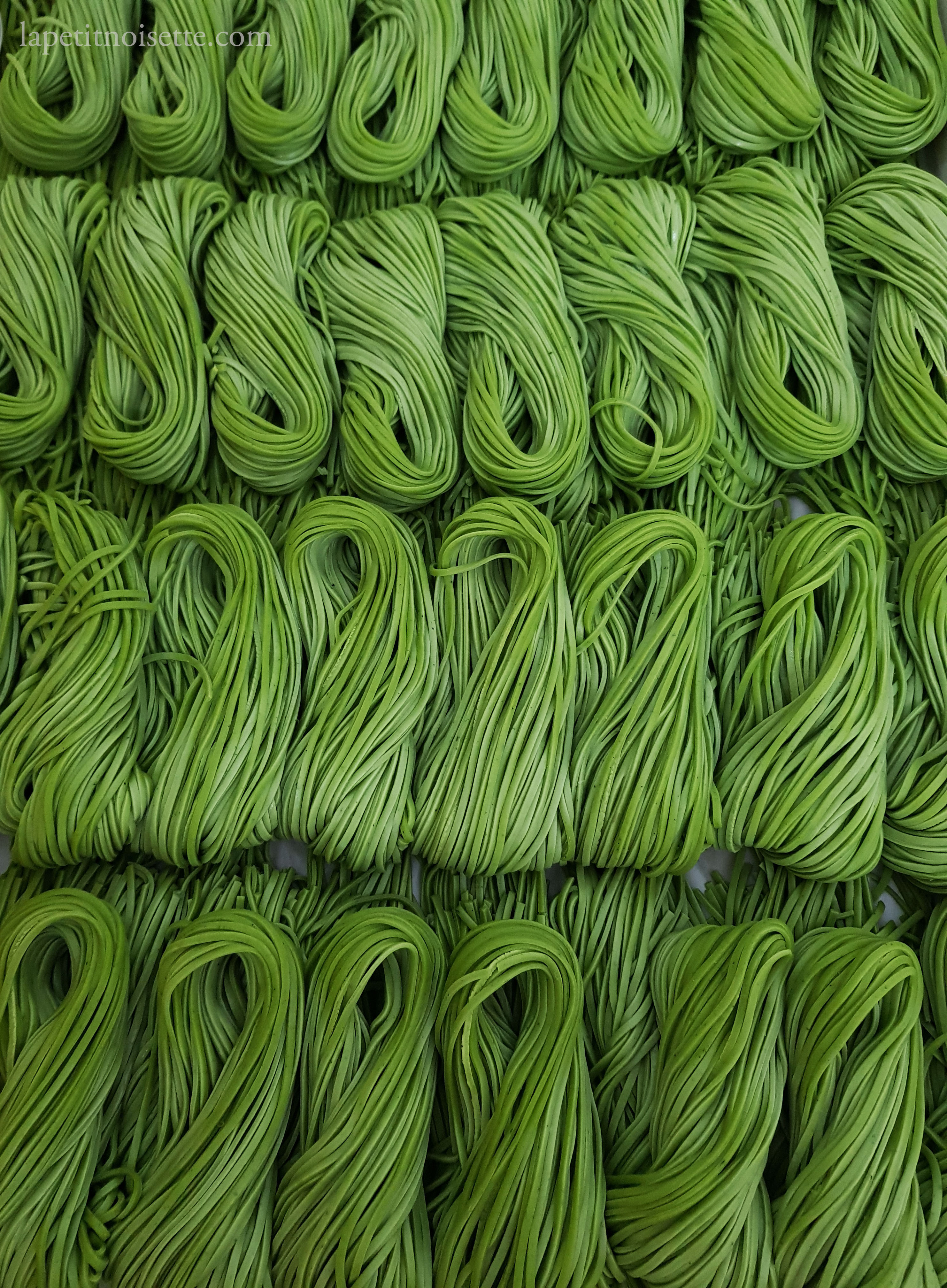
Freezing and its effects
Water trapped in the gluten matrix does not freeze into ice crystals and thus the total amount of water available to form ice crystals in frozen noodles is significantly less compared to, for example, meat.
It should be noted that prolonged freezing will result in a reduction in quality as prolonged freezing will slowly damage the gluten network, resulting in the water trapped by the gluten being absorbed starch granules, thus increasing the “hydration” of the noodles, causing them to be more chewy. As the gluten networks are further damaged, the water absorption capacity of the noodles increases until they are will no longer able to maintain their form.
Why are they yellow?
The yellow colour of ramen noodles originates from two sources, the natural yellow pigments (xanthophylls) in the wheat and the interaction between alkaline salts and flavonoid compounds. The most common yellow pigment is lutein, which is present in the germ and endosperm of wheat grains. [11]
[1] In terms of effect, the addition of alkaline salts to ramen noodles does have a significant effect on gluten structure during noodle. Gluten proteins are connected to each other through disulfide and non-disulfide cross-links. At low alkaline concentrations, the rate disulfide bond formation. Above 1 to 1.5% however, disulfide cross-links are not only inhibited, but also degraded, similar to the addition of acid (though acid works on both disulfide and non-disulfide cross-links). The main contribution of alkaline salts however, is in terms of flavour, with more alkaline added to thicker noodles to maintain the taste of ramen noodles.
[2] Riboflavin is also sometimes added as an artificial colouring to ramen noodle.
[3] These alkaline salts actually undergo an exothermic reaction when mixed with water and will release a small amount of heat which may cause clump in your dough mixture and thus dissolving alkaline salts in water slowly is recommended before adding into the dough.
[4] Cross-link formation does not stop when kneading stops, but continues afterwards.
[5] Environmental wise, the humidity and temperature of the room also affects the hydration of the noodles, albeit to a smaller degree. A high humidity environment would mean that a few percentages less water should be used in the dough as the flour would already be slightly hydrated (e.g. Japan in the summer, tropical countries). The best way to adjust for these changes is through the feel of the dough as you knead it together, although this requires some experience.
[6] Tensile strength means how easy it is to break something by pulling on it
[7] Some chefs add gluten to low hydration noodles to counteract the effect of low hydration
[8] Ppm refers to parts per million. Hardness is often the result of dissolved calcium and magnesium salts, and ppm is a measurement of these salts.
[9] In the same way salt is added to baked goods, salt is added to noodles in small quantities in order to enhance the flavour of the noodles while ensuring the noodles are not significantly more bland compared to the soup and thus more in balance. Salt is rarely added in more than 2% in bread dough as it starts to inhibit yeast activity. In ramen noodles, there is no yeast activity to take into account but salt is generally maintained at around 1-2%.
[10] Similarly in pasta dough, semolina flour is used to dust the pasta and semolina flour has a much lower proportion of gluten compared to wheat flour.
[11] These flavonoid compounds found in wheat mainly consists of glycosides and are synthesised from phenylalanine and the enzyme phenylalanine ammonia lyase. During wheat grain ripening, xanthophylls and flavonoids accumulate up to the middle stages of development but in the case of xanthophylls, decline as the grain further ripens. The amount of xamthophylls and flavonoid compounds are also affected by the milling process as the method of milling will determine the proportion of endosperm in the grain relative to germ and seed-coating.
Excellent article, a joy to read! Thank you.
fantastic article
Great information. Can potassium bicarbonate be baked to potassium carbonate like baking soda?
Yes you can! the reaction is as follows:
2KHCO3 + heat -> K2CO3 + CO2 + H2O
It’s typically used in recipes as a replacement if you want to reduce your sodium intake but it has a bitter after taste so some people prefer not to use it.
Hello,
Super article, thanks. I wonder what your experience is of ageing the dough over several days, or up to a week, prior to rolling? I am thinking about lower temperatures, around 3C.
Really happy to have found your site – as a ramen nerd it is a treasure trove!